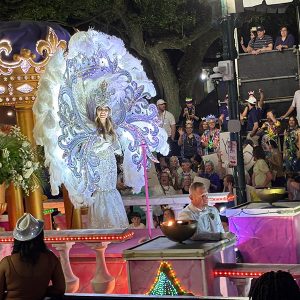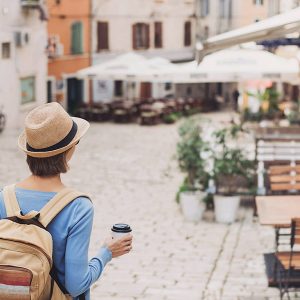Rupert Parker visits the city of Ljubljana, the capital of Slovenia and this year designated as European Green Capital.
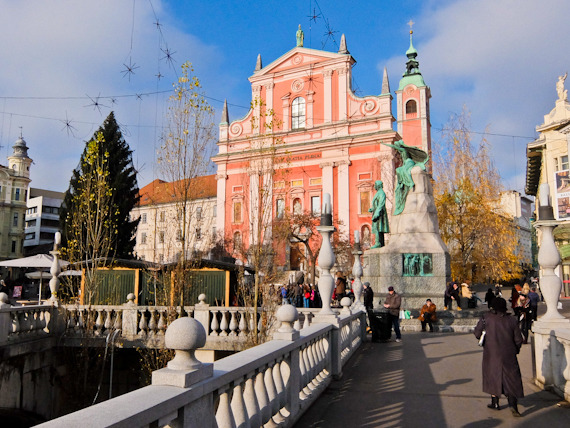 For a city with such an unpronounceable name, Ljubljana is easy to like. It has a remarkable coherent architectural style, known as Vienna Secessionist, similar to Art Nouveau, as it was largely rebuilt after an earthquake in 1895. The centre is pedestrianised and the river cuts the city into two halves, connected by a number of attractive bridges. A medieval castle stands guard, although these days it’s home to a couple of restaurants and a museum, easily accessible by a funicular.
For a city with such an unpronounceable name, Ljubljana is easy to like. It has a remarkable coherent architectural style, known as Vienna Secessionist, similar to Art Nouveau, as it was largely rebuilt after an earthquake in 1895. The centre is pedestrianised and the river cuts the city into two halves, connected by a number of attractive bridges. A medieval castle stands guard, although these days it’s home to a couple of restaurants and a museum, easily accessible by a funicular.
People have been living here since around 2000BC when the settlers built wooden stilt houses on the marshes. They made dugout canoes by hollowing out tree trunks and you can still see one of them in the museum. Later the Romans arrived and built the city of Emona, but it was destroyed by the Huns and the Ostrogoths in 462AD. Ljubljana became part of the Hapsburg Empire in the 13th century and its strategic position on the trade route between the Adriatic and the Danube meant it flourished.
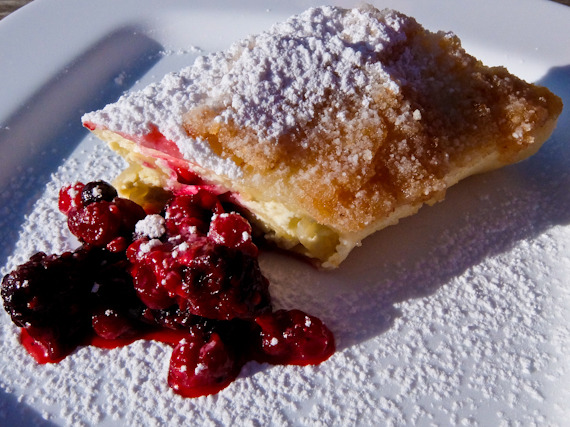 I start my visit by taking a five-minute funicular ride up to the castle overlooking the town. In the early 20th century this served as a prison and you can even visit some of the cells. Of course there’s a fantastic view, although slightly diminished by the mid- morning mist, rising off the marshes. I get to learn about the history by watching a 12-minute film in the museum which with animated computer graphics cleverly shows the castle’s architectural development over time. Just next door, the restaurant Gostilna Na gradu serves traditional Slovenian food and I get my first taste of Struklji – the national dessert is a dumpling stuffed with a mixture of walnuts, rum and raisings. I’m going to be encountering this in different forms over the next few days.
I start my visit by taking a five-minute funicular ride up to the castle overlooking the town. In the early 20th century this served as a prison and you can even visit some of the cells. Of course there’s a fantastic view, although slightly diminished by the mid- morning mist, rising off the marshes. I get to learn about the history by watching a 12-minute film in the museum which with animated computer graphics cleverly shows the castle’s architectural development over time. Just next door, the restaurant Gostilna Na gradu serves traditional Slovenian food and I get my first taste of Struklji – the national dessert is a dumpling stuffed with a mixture of walnuts, rum and raisings. I’m going to be encountering this in different forms over the next few days.
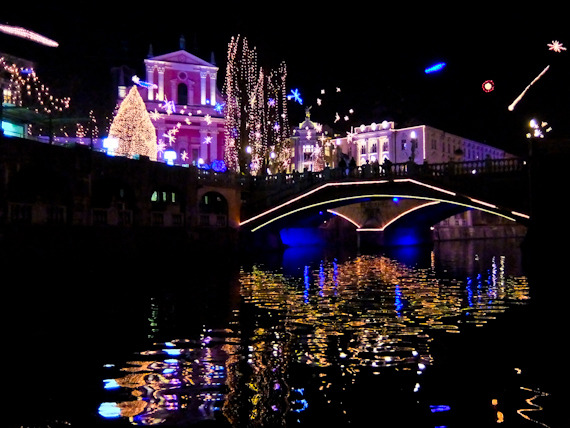 The key feature in the centre is the Triple Bridge, originally built as a single in 1842 but pedestrian arms were added on either side in 1929 to combat traffic congestion. A night cruise on the river gives you the opportunity to get an idea of the town, passing under a number of bridges including the Dragon Bridge adorned with four famous dragon statues. I sip a glass of mulled wine and admire the Christmas lights and vibrant open air bars and restaurants line the banks. Try AS Aperitivo, not quite on the river, but with a patio that gives views of the castle.
The key feature in the centre is the Triple Bridge, originally built as a single in 1842 but pedestrian arms were added on either side in 1929 to combat traffic congestion. A night cruise on the river gives you the opportunity to get an idea of the town, passing under a number of bridges including the Dragon Bridge adorned with four famous dragon statues. I sip a glass of mulled wine and admire the Christmas lights and vibrant open air bars and restaurants line the banks. Try AS Aperitivo, not quite on the river, but with a patio that gives views of the castle.
It’s worth visiting the National Museum of Slovenia which has Roman remains from the city of Emona and also the world’s oldest musical instrument, a cave bear bone hollowed into a flute, over 50,000 years old. In the same building is the Natural History Museum and the highlight here is a reassembled skeleton of a mammoth, 20,000 years old, nearly four metres high and six metres long. Another interesting artefact is in the City museum, this time the world’s oldest wooden wheel, part of a cart from 5150 years ago.
Velika Planina
About 50 km north of the city is the mountain plateau of Velika Planina part of the Kamnik-Savinja Alps, criss-crossed with an extensive network of hiking routes, accessible by cable car. Every summer farmers bring their cows up to the Alp and live here in traditional wooden cottages with huge shingle roofs. To keep their animals safe from wolves, they also share the same space at night. 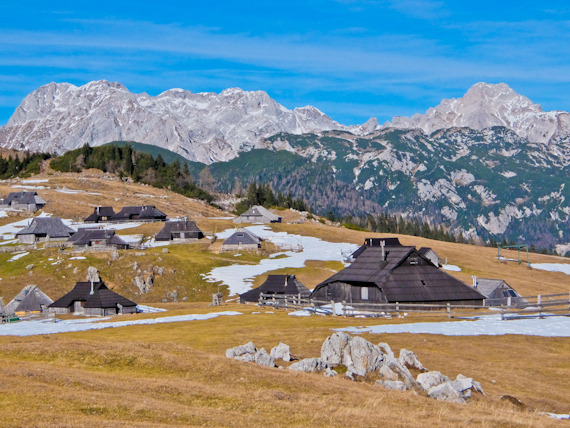 They make a smoked cheese from curds and cream called Trnic. The shape resembles a woman’s breast complete with nipple, and apparently they made them in pairs, one to eat on the mountain, the other to take back to their beloved back in the valley. The village’s sights include Preskar’s Hut museum and the Chapel of St. Mary of the Snows.
They make a smoked cheese from curds and cream called Trnic. The shape resembles a woman’s breast complete with nipple, and apparently they made them in pairs, one to eat on the mountain, the other to take back to their beloved back in the valley. The village’s sights include Preskar’s Hut museum and the Chapel of St. Mary of the Snows.
At the first stop of the chairlift is Zeleni Rob, a simple restaurant serving Slovenian mountain specialities. Their thick soup, Ricet, containing barley, beans, potatoes, carrots and dried pork is excellent. They have two types of sausage, accompanied by buckwheat porridge, topped with chopped pieces of fat, unhealthy but delicious. For dessert, you get what some would say is Slovenia’s best Struklji and this version is stuffed with curd cheese.
Vrhnika
20 km west of Ljubljana, is the village of Vrhnika, famous for being the birthplace of Ivan Cankar, a celebrated Slovenian writer. It’s also home to The Human Fish Brewery, named after the strange eel-like creature which live in the nearby caves. On Friday afternoons and weekends the brewery welcomes visitors to their make-shift bar to sample their pale ale, stout and IPA, as well as their seasonal beers.
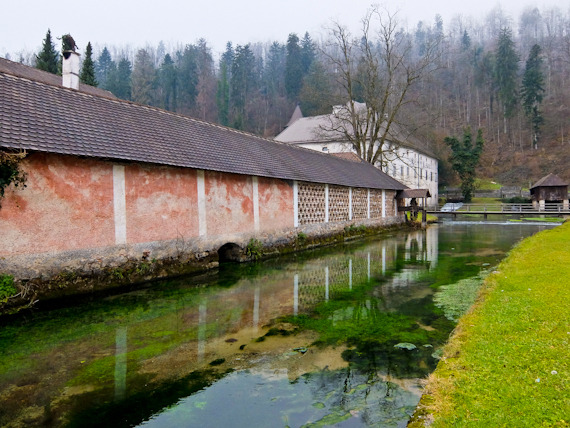 5 km outside town, Bistra Castle was originally a monastery and still retains its extensive grounds and ponds. These days the buildings are occupied by the Technical Museum of Slovenia, which includes a flour mill, a water-powered smithy, a reconstructed veneer mill, and a Venetian sawmill. The real reason for visiting is to see the collection of fifteen cars used by the former Yugoslav President Tito.
5 km outside town, Bistra Castle was originally a monastery and still retains its extensive grounds and ponds. These days the buildings are occupied by the Technical Museum of Slovenia, which includes a flour mill, a water-powered smithy, a reconstructed veneer mill, and a Venetian sawmill. The real reason for visiting is to see the collection of fifteen cars used by the former Yugoslav President Tito.
They include, a 1939 Mercedes-Benz, a 1937 Packard, a gift from Stalin in 1945, two 1954 ZISs from Khrushchev, a Horch 951A from the Russian Third Army, and a 1952 Rolls Royce.
For a fantastic view of the area, it’s worth a trip to the top of the Planina hill and climbing the 22 m viewing tower. The mist mystically hugs the valley and you can see almost all of Slovenia from here. On clear days the view extends from Mount Triglav in the Alps to the Adriatic. Another reason to visit is to sample another version of Struklji, this time stuffed with prunes, at the Planina Lodge nearby.
More information
The tourist office in Ljubljana organises tours of the city and outlying areas. English is widely spoken and there is a well-developed public transport system.
Welcome to Ljubljana has more information about the city as a green capital.
I Feel Slovenia has more information about the country.
Hotel Slon makes a comfortable base in the centre. Rooms with breakfast start at €200 based on two people sharing.
The Trnulja Country Estate is 7 km outside Ljubljana and is a working organic farm with goats, donkeys and fields of hemp, soy beans and vegetables with apartments built solely with sustainable eco materials – perfect for visiting Europe’s Green Capital 2016.
Wizz Air operates three weekly flights to Ljubljana on Mondays, Wednesdays and Fridays from London Luton. Fares start from £25.99 for a one-way ticket, including all taxes and non-optional charges.
Ibis Luton is convenient for early flights. Rooms from only £52. 01582 424488.



